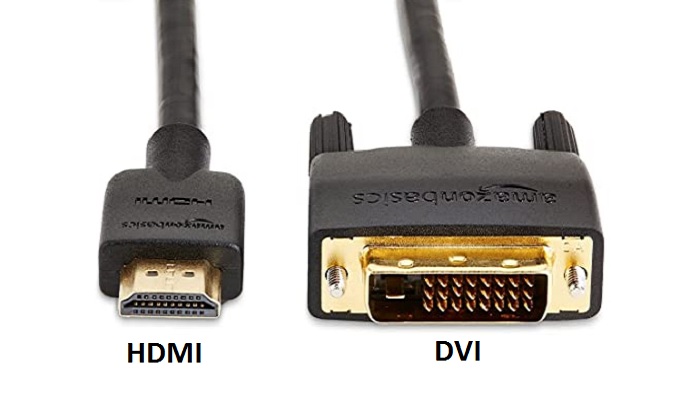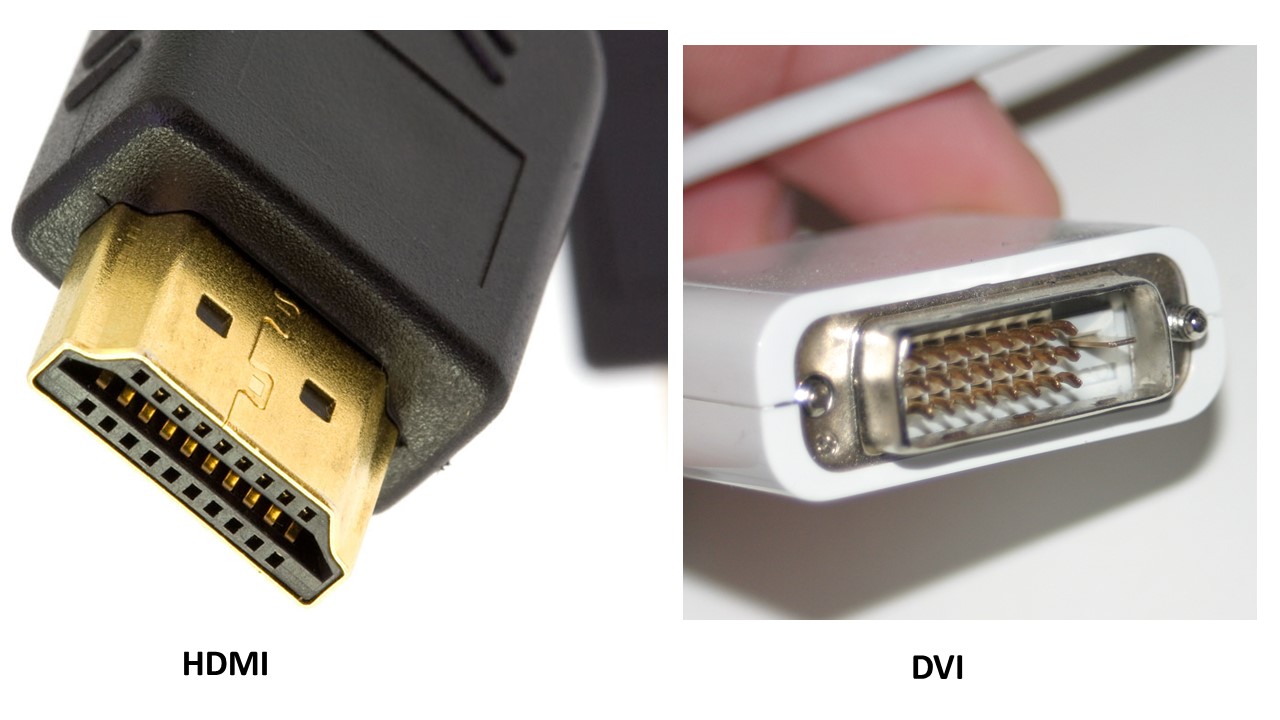Typically, HDMI and DVI are the two of the most common types of interfaces used in video displays.
Now, the question is how exactly will you know which among the two interfaces is better for your kind of user, and accordingly, which type of cable you would need to choose for it to get running?
Well, for that you will need to know the differences between an HDMI and a DVI in the first place.
In This Article
KEY TAKEAWAYS
- DVI is an older technology being developed by Digital Display Working Group in 1999 but HDMI was developed by a consortium of electronic companies in 2003.
- DVI supports VGA connection but only video signals but HDMI supports audio signals as well as video signals.
- DVI is more complex than HDMI in terms of standards and is larger than HDMI in size as well.
- The DVI cables usually come with a 24-pin layout while HDMI may have 19 to 29 pins.
The 16 Differences Between DVI and HDMI

1. Acronyms
DVI stands for Digital Visual Interface and HDMI stands for High Definition Media Interface.
2. Age
DVI is a slightly older technology having arrived in the market in 1999 in comparison to the HDMI which made its first appearance in the consumer market a few years later than that in 2003.
3. Creators
The DVI graphical standard is created by the Digital Display Working Group or DDWG.
On the other hand, the founders of HDMI are Hitachi, Silicon Image, Sony, Panasonic, Philips, and Toshiba.
However, its specs are controlled by Silicon Image Subsidiary HDMI Licensing, LLC.
4. Support
The Digital Visual Interface video standard is available in several formats and supports VGA connection.
However, it supports only video signals but does not support audio signals.
Therefore, you will need to use external speakers and audio cable for it.
On the other hand, HDMI supports both audio and video signals and therefore it is the simplest interface to use in computer monitors.
This interface can support up to 32-channel audio and includes Dolby Digital, DTS, DTS-HD Master Audio, MPCM, DVD-Audio, Dolby Digital Plus, Dolby TrueHD, LPCM, Super Audio CD, DTS-HD High Resolution Audio, DSD, and DST.
5. Size and Complexity
The DVI standard is much more complex in comparison to the HDMI standard. And, the size of it is also larger.
On the other hand, the HDMI is a much smaller connection which looks more like an outsized USB or Universal Serial Bus than anything else.
It is also one of the simplest standards to use.
6. Layout
DVI, the cables to be more precise, comes in different layouts but the most common one is the one with a 24-pin setup.
It looks much more like the SCART lead, where SCART stands for Syndicat des Constructeurs d’Appareils Radiorécepteurs et Téléviseurs, French for Radio and Television Receiver Manufacturers.
On the other hand, the HDMI are also available in different models but have a very simple layout and depending on the type it can support 19 to 29 pins.
7. Usage
DVI is commonly used in desktop computers and LCD monitors.
On the other hand, the HDMI is the default standard that you will find in new HDTVs, Apple TVs, Blu-Ray players, new computers and other video equipment.
8. Capabilities
The DVI standard can support up to 1920 x 1200 pixels HD video or 2560 x 1600 pixels resolution with their dual link variants.
However, it will not stream HDCP encryption by default which is why you may not be able to play full HD or other HD contents.
HDMI, on the other hand, can support digital video signals and audio signals for up to 1920 x 1200 pixels HD video resolution with 8 channel audio.
Apart from that, it also supports HDCP encryption.
9. Types
There are different types of DVI connectors available in the market such as DVI-D or digital only connector, DVI-A or analog only connector, and DVI-I that can be connected with both analog and digital equipment.
On the other hand, the different types of HDMI connectors available are Type A, Type B, Type C or mini connector, Type D or micro connector, and Type E.
10. Cost Factor
The DVI is less expensive in comparison to the HDMI.
However, there are a few new variants of HDMI that are not as expensive as the other models.
11. Compatibility
The DVI is compatible with other standards such as VGA and HDMI and can convert them.
On the other hand, the HDMI is compatible with DVI and VGA but with converters.
12. Maximum Data Rate Support
DVI can support a maximum data rate of up to 9.9 GB/s.
In comparison, the HDMI can support a maximum data rate of up to 42.6 GB/s.
13. Maximum Resolution Support
The DVI can support a maximum resolution of up to 3840 X 2400 pixels at 30 Hz.
On the other hand, the HDMI can support a maximum resolution of up to 8K at 120 Hz.
14. Maximum Refresh Rate
The DVI can support a refresh rate of up to 144 Hz but, in comparison, the HDMI can support a refresh rate of up to 144 Hz for 4K and up to 120 Hz at 8K.
15. Availability
The DVI is available on older monitors but, in comparison, all newer monitors are equipped with an HDMI.
16. Ease of Use
The multiple variants of DVI ports and cables need the users to make sure they use the right cable and the right ports on the monitor and the graphics cards.
On the other hand, the HDMI is much easier to use due to its universal shape which allows it to fit into any computer system and monitor that comes with an HDMI connector.
Which is Better to Use – DVI or HDMI?

When it comes to making a choice between two given computer peripherals, it is expected that you make your judgment on the basis of suitability, compatibility and your preference.
The same principle applies to choosing between DVI and HDMI.
Looking at the differences mentioned above, HDMI seems to have an edge over DVI and there are lots of reasons for that.
Apart from the list of differences above, here are a few other facts and information about these two types of connections summarized for you which will help further in making the right choice.
DVI is favored especially because it offers higher refresh rates and compatibility with older types of connections such as VGA or Video Graphics Array.
However, HDMI has almost replaced DVI. Since its launch, HDMI has become the standard for HD or UHD video as well as for the video recording hardware.
Also, DVI is a more complex connection type as compared to HDMI and therefore if you are looking for simplicity, DVI is not your cup of tea. And, as said earlier, DVI will not support audio signals as the HDMI would.
However, there is one significant point of similarity between the HDMI and the DVI, especially in the cables.
The cable types of both DVI and HDMI follow CEA-861 standard.
This means that the signals that are carried by an HDMI are also compatible with DVI and you will simply have to use an adapter in order to convert the HDMI connection into a DVI connection and vice versa.
This will normally not result in the loss of signal or picture quality.
Most of the users, average and professionals, prefer to use HDMI over DVI because it is a more modern technology and supports higher resolutions and refresh rates.
Most importantly, an HDMI will be compatible with a much wider variety of computer peripheral devices in comparison to a DVI.
However, this does not mean you will need to discard the DVI machine that you already have if you want to hook up to another system.
This is because you can simply use an HDMI to DVI adapter or a cable for the necessary conversion to be made in the video signals.
Whichever option you choose for that matter it will not cost a fortune.
If price is a factor for you then you may go for a DVI but then the high benefits offered by an HDMI will balance off the high cost in due time.
Therefore, if you do not really have to, there is no good or strong reason to stick to a DVI.
Moreover, if you have a computer or a laptop that supports only DVI and there is an audio output port in it as well and the monitor also supports a DVI and an audio input, there is really no need for upgrading any one either.
An HDMI is a good option for the avid gamers who want an upgraded and high-end 4K monitor or monitors for gaming.
This will enable them to take full advantage of the connection while streaming HD videos that are mostly available online these days.
In such a situation they will be better off with an HDMI 2.0 which will offer a very high resolution and rate of data transfer.
However, it is required to make sure that both the monitor as well as the graphics card support HDMI.
Otherwise, a DVI that supports a resolution of up to 2560 x 1600 pixels at 60 Hz will be more than enough to meet with almost all the needs of standard desktop computing.
Therefore, in the end, it can be said that HDMI or High Definition Media Interface is much more improved in comparison to the Digital Visual Interface or DVI in a lot of ways.
Typically, HDMI is the future of the world of computers and DVI is the past, though it would be wrong to think it is obsolete, as of now.
Conclusion
Hopefully, this article has helped you a lot in understanding the differences between DVI and HDMI.
You will surely find it very easy now to make a choice between the two types of connectors based on your needs and preferences if you keep this list of differences handy.